The Worst of Times happens to the turtles 41K JPEG | 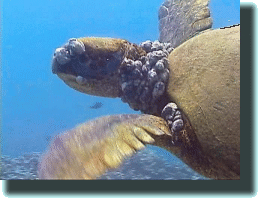
|
I keep remembering A Tale of Two Cities. It starts, "It was the Best of Times. It was the Worst of Times..." and that describes Summer 2000 pretty well--except that the Worst of Times happens to the turtles.
The Worst of Times happens to the turtles 41K JPEG | 
|
The last week of August has become increasingly awkward because we must talk about our flight back and our inevitable return to... where?
Well, the last two years now we have been unable to say that we're going "home" as we prepare to leave Maui. Our tongues tend to stub their toes on that H-word. Home is indeed where the heart is and our hearts belong to a stretch of ocean.
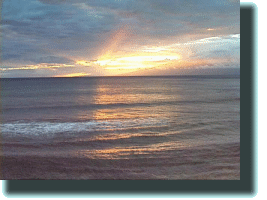
| Our hearts belong to a stretch of ocean 42K JPEG |
Simple as that.
And Home is about Place.
Places we have known for over a decade now. The Turtle House, The Rock, Reef 2, East House, The Battery--all first discovered by us in 1989.
And places explored just last summer. Hale Manu. North House. Mt. Balazs.
And places newly discovered this year. Discovery is so exhilarating--exploring farther than ever before.
We'd love this underwater place even if there weren't turtles living here. But there are.
Lots of them.
Every summer brings with it new faces. In early July, these "faces" retreat at our approach, and then somewhen and somehow they accept our presence. The newest brightest face at Honokowai this summer was Pumehana.
The newest brightest face at Honokowai this summer was Pumehana 46K JPEG | 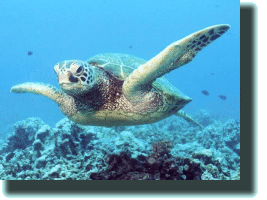
|
Typically she'd go for air the moment we arrived, then watch us from the safety of the surface. But it didn't take long for her to greet our arrival with nonchalance and later, announce her own arrival by landing on me, beside me, or even under me.
The new face that made the biggest "splash" was an odd-looking turtle that scientists believe to be either a black turtle or a Hawaiian/black mix. We named her Ho'omalu and she provided us with many special memories.
And my best photograph of the summer.
On one of our last dives we saw Ho'omalu resting at her favourite place, a large coral head we named Mt. Balazs. What makes this photo special is on this particular day, two of our tagged females were also parked there. One of them, Shredder, newly returned from nesting at French Frigate Shoals, bears 223U engraved neatly on her shell. The other was McTaggert, who has been resident of Honokowai since 1992.
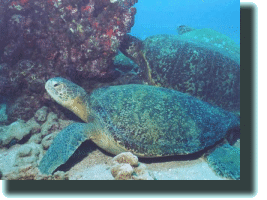
| Ho'omalu, Shredder, and McTaggert at Mt. Balazs 56K JPEG |
A wonderful moment...
Nui, known since 1990, was his aloof self all summer. Our Matriarch, Tutu (also known since 1990), had taken the year off her nesting duties and was a regular sight along Reef 2. Zeus, like every summer since 1992, was also about, hanging around North House or Reef 2 depending on his mood.
Tamu, an engaging turtle we've known since 1995, has outgrown his cuteness and traded it for the impressive silhouette of a honu adult male.
Tamu, an engaging turtle we've known since 1995 26K JPEG | 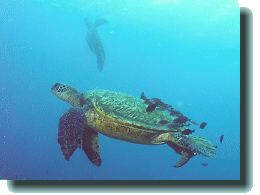
|
Fibropapilloma. Every summer we learn more. There's this "seeing" that comes with experience and we believe that we can recognize FP's early symptoms better.
This summer, something appears to have happened to our Hang-Tough-Turtles, a small cluster of individuals that have managed to remain free of FP since we first sighted them in the early Nineties.
These include one honu from 1991, and McTaggert, Ho'oulu, and Fred--all turtles from 1992 who'd had through the years remained disease-free.
Until now.
This summer, close inspection of the eyes of each of these turtles reveal warping and abnormalities that suggest one of two things. They either had fibropapilloma and are actually regression cases (possible since we have incomplete histories on these turtles) or they are getting the disease only now.
If our "read" on the eyes are correct, we believe that three turtles (1991 Turtle 7, Ho'oulu, and Fred) are getting the disease.
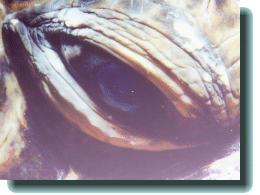
| Right eye of Ho'oulu, overexposed to reveal detail 33K JPEG |
We feel, however, that McTaggert is actually a regression case and we missed her tumor stage either because she was away for a summer nesting at the Shoals, or we just didn't get close to her enough to notice.
Our database shows that we have 22 turtles that were sighted in at least 5 summers including this one. Should we be correct about our Hang-Tough-Turtles--that they too have the disease--we can conclude that the true FP rate at Honokowai is 100%.
That is, if a turtle hangs around long enough (sighted five summers or more) it will get sick. The contagion is that efficient.
As nasty as fibropapilloma is to honu, it saves its greatest evil for the littlest. Summer 2000 was memorable in another way. Every single small turtle we sighted this summer looked back at us with tumored eyes.
Every single small turtle we sighted this summer looked back at us with tumored eyes 41K JPEG | 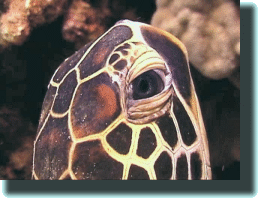
|
That is also 100%.
Ironic considering that we arrived on Maui thinking that if FP is environmentally-driven, then perhaps the drought that Maui has been experiencing over the last three years might help the honu. Less rain, less run-off… might douse a bit of the FP fire.
We were hoping for more regression cases this summer, delayed onset of the disease in others, fewer severe cases...
But we were wrong. The drought brought no reprieve.
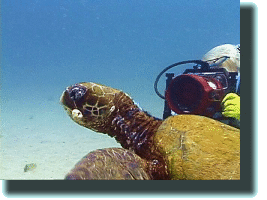
| The drought brought no reprieve 50K JPEG |
 Who's Who Underwater at Honokowai
Who's Who Underwater at Honokowai